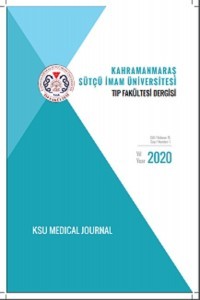Serum 25-Hidroksi Vitamin D Düzeyi Siğil Şiddetini Yansıtmaz: Kesitsel Bir Çalışma
Hastalık şiddeti, Serum 25-hidroksi D vitamini, Verruka vulgaris
Serum 25-Hydroxy Vitamin D Level Does Not Reflect The Severity of Wart: A Cross-Sectional Study
Disease severity, Serum 25-hydroxy vitamin D, Verruca vulgaris,
___
- Egawa K, Ono T. Topical vitamin D3 derivatives for recalcitrant warts in three immunocompromised patients. Br J Dermatol. 2004;150(2):374–376.
- Mitsuhashi Y, Kawaguchi M, Hozumi Y, Kondo S. Topical vitamin D3 is effective in treating senile warts possibly by inducing apoptosis. J Dermatol. 2005;32(6):420–423.
- Imagawa I, Suzuki H. Successful treatment of refractory warts with topical vitamin D3 derivative (maxacalcitol, 1 alpha, 25-dihydroxy-22-oxacalcitriol) in 17 patients. J Dermatol. 2007;34(4):264–266.
- Moscarelli L, Annunziata F, Mjeshtri A, Paudice N, Tsalouchos A, Zanazzi M et al. Successful treatment of refractory wart with a topical activated vitamin d in a renal transplant recipient. Case Rep Transplant. 2011;2011:368623.
- Osborne JE, Hutchinson PE. Vitamin D and systemic cancer: is this relevant to malignant melanoma? Br J Dermatol. 2002;147(2):197–213.
- Aktaş H, Ergin C, Demir B, Ekiz Ö. Intralesional vitamin D injection may be an effective treatment option for warts. J Cutan Med Surg. 2016;20(2):118–122.
- Raghukumar S, Ravikumar BC, Vinay KN, Suresh MR, Aggarwal A, Yashovardhana DP. Intralesional Vitamin D3 Injection in the Treatment of Recalcitrant Warts: A Novel Proposition. J Cutan Med Surg. 2017;21(4):320–324.
- Kavya M, Shashikumar BM, Harish MR, Shweta BP. Safety and efficacy of intralesional vitamin D3 in cutaneous warts: an open uncontrolled trial. J Cutan Aesthet Surg. 2017;10(2):90–94.
- Jakhar D, Kaur I, Misri R. Intralesional vitamin D3 in periungual warts. J Am Acad Dermatol. 2019;80(5):111–112.
- Öztekin C, Öztekin A, Taştan K, Özmen GG, Pektaş SD. The association between verruca vulgaris and vitamin D: is there a casual link? Acta Medica Mediterranea, 2018,34(4):1047–1050.
- Tamer F, Yuksel ME, Karabag Y. Pre-treatment vitamin B12, folate, ferritin, and vitamin D serum levels in patients with warts: a retrospective study. Croat Med J. 2020;61(1):28–32.
- Mostafa WZ, Hegazy RA. Vitamin D and the skin: Focus on a complex relationship: a review. J Adv Res. 2015;6(6):793–804.
- Yakoob MY, Salam RA, Khan FR, Bhutta ZA. Vitamin D supplementation for preventing infections in children under five years of age. Cochrane Database Syst Rev. 2016;11:CD008824.
- Kechichian E, Ezzedine K. Vitamin D and the skin: An update for dermatologists. Am J Clin Dermatol. 2018;19(2):223–235.
- Muehleisen B, Bikle DD, Aguilera C, Burton DW, Sen GL, Deftos LJ et al. PTH/PTHrP and vitamin D control antimicrobial peptide expression and susceptibility to bacterial skin infection. Sci Transl Med. 2012 May 23;4(135):135ra66.
- Bergler-Czop B, Brzezin ´ska-Wcisło L. Serum vitamin D level: the effect on the clinical course of psoriasis. Postepy Dermatol Alergol. 2016;33(6):445–449.
- Heine G, Hoefer N, Franke A, Nothling U, Schumann RR, Hamann L et al. Association of vitamin D receptor gene polymorphisms with severe atopic dermatitis in adults. Br J Dermatol. 2013;168(4):855–858.
- Upala S, Sanguankeo A. Low 25-hydroxyvitamin D levels are associated with vitiligo: a systematic review and meta-analysis. Photodermatol Photoimmunol Photomed. 2016;32(4):181– 190.
- Aksu Cerman A, Sarikaya Solak S, Kivanc Altunay I. Vitamin D deficiency in alopecia areata. Br J Dermatol. 2014;170(6):1299– 1304.
- Incel Uysal P, Alli N, Hayran Y, Candar T. Mycosis Fungoides and Vitamin D Status: Analyses of serum 25-Hydroxyvitamin D Levels and single nucleotide polymorphisms in the Vitamin D Receptor Gene. Acta Dermatovenerol Croat. 2018;26(1):8-14.
- Mok CC, Birmingham DJ, Ho LY, Hebert LA, Song H, Rovin BH. Vitamin D deficiency as marker for disease activity and damage in systemic lupus erythematosus: a comparison with anti-dsDNA and anti-C1q. Lupus. 2012;21(1):36–42.
- Giuggioli D, Colaci M, Cassone G, Fallahi P, Lumetti F, Spinella A et al. Serum 25-OH vitamin D levels in systemic sclerosis: analysis of 140 patients and review of the literature. Clin Rheumatol. 2017;36(3):583–590.
- Lim SK, Ha JM, Lee Y, Seo YJ, Kim CD, Lee JH et al. Comparisonof vitamin D levels in patients with and without acne: A case-control study combined with a randomized controlled trial. PloSOne. 2016;11(8):e0161162.
- Kemeriz F, Tuncer SÇ, Acar EM, Tuğrul B. Evaluation of 25-hydroxy vitamin D levels and disease severity in patients with acne vulgaris [published online ahead of print, 2020 Apr 8]. Dermatol Ther. 2020;33(3):e13393.
- Navarro-Triviño FJ, Arias-Santiago S, Gilaberte-Calzada Y. Vitamin D and the skin: A review for dermatologists. Actas Dermosifiliogr. 2019;110(4):262-272.
- Solak I, Cihan FG, Mercan S, Kethuda T, Eryılmaz MA. Evaluation of 25-hydroxyvitamin D levels in central Anatolia, Turkey. Biomed Res Int. 2018;2018:4076548.
- ISSN: 1303-6610
- Yayın Aralığı: Yılda 3 Sayı
- Başlangıç: 2004
- Yayıncı: Kahramanmaraş Sütçü İmam Üniversitesi
Karaciğer Sirozu Tanısı ile Takip Edilen Konstriktif Perikardit Olgusu
Murat KERKÜTLÜOĞLU, Enes ÇELİK, Bayram ÖZTÜRK, Hakan GÜNEŞ
Gebelikte Ödem ve Proteinürinin Çok Nadir Görülen Bir Nedeni: Mirror Sendromu
Abdullah TOK, Fatma Betül GÜZEL, İlyas OZTURK, Ertuğrul ERKEN, Orçun ALTUNÖREN, Özkan GÜNGÖR
Refika KILIÇKAYA, Yavuz ORAK, Filiz ORAK, Adem DOĞANER
Kikuchi-Fujimoto Hastalığı mı, Lenfoma mı?
Sema YILDIRIM, Ayşe AŞIK, Bengü ÇOBANOĞLU ŞİMŞEK, Ayşe BOZKURT
Kronik Aort Yetmezliği Olan Hastalarda Hipertansiyon Sıklığı
Oguzhan YÜCEL, Hakan GÜNEŞ, Mehmet Birhan YILMAZ
112 Ambulans Çalışanlarının Hizmet ve Sosyal Durumlarının Değerlendirilmesi
Muhammed Semih GEDİK, Hakan HAKKOYMAZ, Nuri Mehmet BASAN, Yılmaz SAFİ, Erdem AKSAY
İnterdiyalitik Kilo Alımının Kardiyovasküler Mortalite ve Morbidite Üzerine Etkisi
